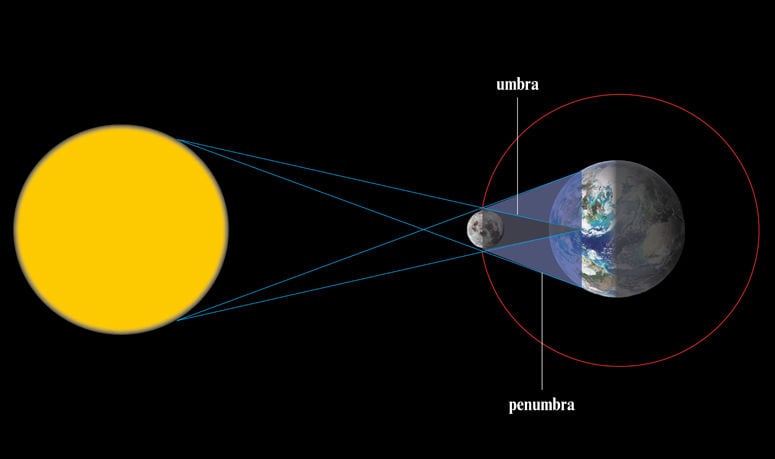

The third contact occurs when the first bright light appears, and the Moon's shadow moves away from the observer.Totality occurs when the Moon obscures the entire disc of the Sun, leaving only the solar corona visible.The second contact begins with Baily's Beads (caused by light shining through valleys on the Moon's surface) and progresses to the diamond ring effect.First contact occurs when the Moon's limb (edge) is directly parallel to the Sun's edge.The visual phases seen during a total eclipse are referred to as:

A hybrid eclipse occurs when the magnitude of an eclipse changes during the event from less than one to greater than one, causing the eclipse to appear total near the midpoint and annular near the beginning and end because the sides of the Earth are slightly further away from the Moon. During this type of eclipse, the bright ring around the Moon is known as the "ring of fire."Īn annular/total eclipse (also known as a hybrid eclipse) alternates between total and annular eclipses. Because of the Moon's elliptical orbit, it gets closer to Earth. Because it takes well over 90% coverage to notice any darkening, partial eclipses have almost no effect on the brightness of the Sun.Īn annular eclipse occurs when the Moon, even when perfectly centred in front of the Sun, does not completely obscure it. However, because the umbra never intersects the Earth's surface and passes above the polar regions, some eclipses can only be seen as partial eclipses. This phenomenon can usually be seen from a large portion of the Earth that is not directly in the path of an annular or total eclipse. A partial eclipse of the Sun may be visible in areas outside this track.Ī partial eclipse occurs when the Sun and Moon are not exactly aligned with the Earth, and the Moon only partially obscures the Sun. During a total eclipse, totality can only be seen from a specific area, typically 160 km (100 mi) wide and 16,000 km (10,000 mi) long. This narrow path is referred to as the path of totality. During any given eclipse, totality occurs only on a narrow track on the Earth's surface. When the Moon's dark silhouette completely obscures the Sun's intensely bright light, the much fainter solar corona can be seen. Solar eclipses are classified into four types:Ī total solar eclipse occurs when the Moon completely obscures the Sun from Earth's perspective. If everything is in place, the Moon will cast a shadow on us, resulting in a solar eclipse. It only happens on new moon days because the Moon is between the Earth and the Sun, so the side facing us is the dark side. This happens when the Sun, Moon, and Earth are in the same line. There are two types of eclipses on Earth:Ī Solar Eclipse occurs when the Moon passes between the Sun and the Earth, partially or completely blocking the Sun's rays and casting a shadow on portions of the Earth. As a result, neither can be seen in space by the observer. Thus, this leads to the formation of an eclipse. Eventually, the three celestial bodies will align in a straight line. The Moon, in turn, revolves around the Earth in its orbit. In its orbit, the Earth revolves around the Sun like the other planets.
Umbra eclipse definition license#
All glossary terms and their definitions are released under a Creative Commons CC BY-4.0 license and should be credited to "IAU OAE".Eclipse is an astronomical phenomenon that occurs when one spatial object passes through the shadow of another.
Umbra eclipse definition full#
You can find a full list of credits here. The terms and definitions were chosen, written and reviewed by a collective effort from the OAE, the OAE Centers and Nodes, the OAE National Astronomy Education Coordinators (NAECs) and other volunteers. The OAE Multilingual Glossary is a project of the IAU Office ofĪstronomy for Education (OAE) in collaboration with the IAU Office of Astronomy

This term and its definition have been approved by a research astronomer and a teacher Alternate meaning: the inner, darker region of a sunspot is called its umbra, the surrounding less dark region its penumbra. If an observer sees the covering object as too small to cover the object behind it completely, as in an annular solar eclipse, the observer is said to be in the antumbra. An observer located in the penumbra region, on the other hand, will only see a partial eclipse in the case of a solar eclipse, the Sun's disk covered only partially by the Moon. For a solar eclipse, for instance, any observer in the umbra will see the Sun's disk covered completely by the disk of the Moon. In the context of eclipses, the umbra is that region of space where an observer sees the one body block the other's light completely. Description: Umbra is Latin for "shadow".


 0 kommentar(er)
0 kommentar(er)
